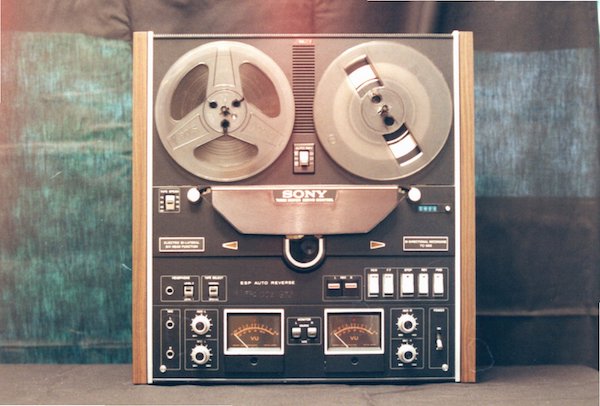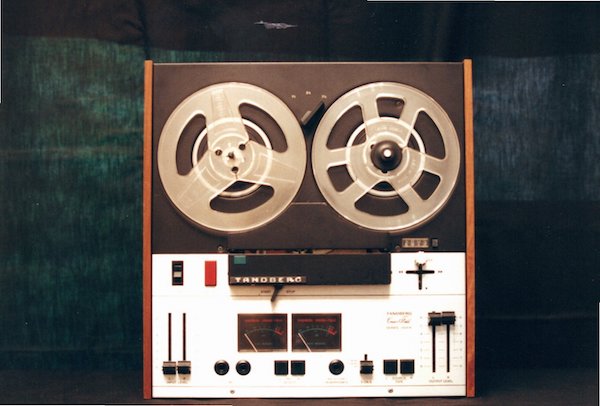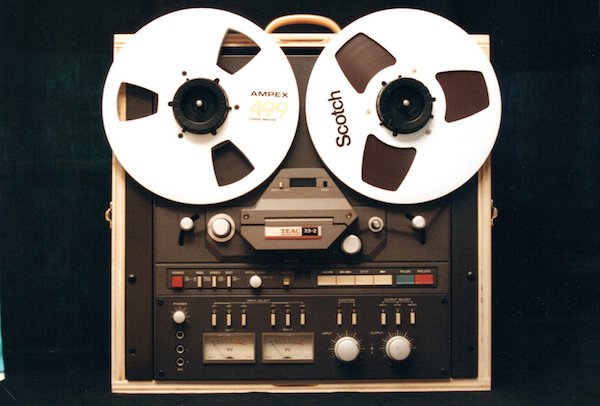Tascam 32 (a.k.a. Teac Tascam Series 33-2)
DESCRIPTION:Available to the present day, this is a professional format deck, with three motors, three heads, two speeds (7 1/2 in/sec and 15 in/sec), and half track heads. Obviously built to stand up to punishment, the machine is built entirely of metal, just like the good old days! There are many controls which wouldn't be found on the usual home tape recorder, such as a 12% pitch control (which is a heck of a lot of fun to play with!); "Edit" control, which turns off the takeup reel motor, 20db attenuators for the mic inputs, etc. A nice four digit florescent tape counter is included, along with "Return to Zero", which can rewind back to a given point anywhere in the reel and stop automatically. Transport controls are by small plastic keys with a very small amount of motion. The quality doesn't come cheap: the current list price is $2,400.00 (remember, this was in 1999).
COMMENTS: This deck was rescued from the state surplus warehouse at the same time as the Pioneer deck, and cost the same- $25.00! It was in much worse shape, though, as case parts were missing, the main transport logic circuit board had been broken in two places, etc. I thought, if I can fix this one, I could fix anything! Fortunately, parts are still easily available from Teac, which made it easier. The first major problem was with the transport mechanism- play and fast winds were fine, but it couldn't stop! Tape would spill everywhere as the reels slowed down. Upon teardown, it was discovered that the deck had a SEVERE case of rubber deterioration. The solenoids which activate the reel brakes and the tape lifter/pinch roller arm had rubber o-rings behind the plunger to quiet them down (the o-rings prevented the head of the plunger from hitting the barrel of the solenoid). The o-rings had become something that resembled half dried automotive gasket maker- in other words, sticky goo.(Note also that the pinch roller was melting in my fingers as I took the deck apart.) The solenoids struggled to move against the glop. Cleaning off the rubber and lubricating the plungers solved the problem (I replaced the o-rings with tightly woven felt washers to keep the noise down). The second major problem was in the playback electronics. Output in "Sync" mode (playback from head two) was dead in the right channel, and there was no output in "Repro" (playback from head three) mode at all. To fix these problems, a copy of the tech manual, available from Teac for $30.00, was essential. The Sync mode problem was a fault in the record/playback amplifier board, specifically, the "K102" Mute Relay, which mutes the output when switching between output modes. The Repro problem was traced to a faulty switch on the output selector circuit board. Rather than shell out whatever Teac wanted for that board, I rigged up a SPST 24v relay to take the place of the bad switch contact. The missing parts have been replaced, and the deck works like a champ.
SPECIAL NOTES: While this was an extremely challenging project, it was made easier by two factors: first is the availability of an incredibly detailed technical manual, second is the outdated technology used in the deck. It's amazing that these decks, still being sold today, are filled to the gills with discrete components (when was the last time you saw a 1N34 style germanium diode used in anything, much less pro audio equipment?), electromechanical relays in the signal path, and rows of 7400 quad Nand gates in the transport logic. It's the height of early 70's technology! This can be a big advantage, though, as all of the electronic parts needed to fix the thing came from Tech America or Radio Shack, and cost a total of about $10.00! Here's a tip: realizing that the playback amplifiers were just dual 741 type op amps, I replaced them with more up to date Bi-Fet op amps to get that last bit of gain and lower noise. It costs about $3.00 to do it, and it makes the deck that much better. Everything said and done, this machine sounds better than it has any right to (which is to say, amazing), and harks back to another age of audio equipment.(Tech America doesn't exist as such, but Radio Shack sort of does. Of course you can find anything online in 2021).



